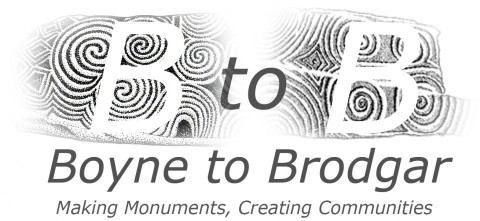There remains an active debate about the nature, agency and timing of the appearance of Neolithic monumentality in Ireland and Britain that requires the excavation and dating of monuments, and the dating of finds from old excavations, in order to resolve the conflicting viewpoints. In essence, one of us (Sheridan 2010a; 2014a) has argued that the practice of constructing monuments – in this case, principally funerary in nature – was introduced from different parts of the north of France by immigrant farmers as part of a multi-strand process of Neolithisation: we are thus dealing with two discrete Continental traditions within the area of interest of the Boyne to Brodgar initiative. According to this model, the passage tomb tradition – which is represented in its earliest form by closed chambers and simple passage tombs distributed along the west coast of Scotland and Wales, and around the coast in the northern part of Ireland (including at the Carrowmore cemetery) – was introduced at some time between c 4300 BC and 3900 BC by settlers from the Morbihan region of Brittany. This is argued not only on architectural grounds but also because the type of pottery found in the Achnacreebeag simple passage tomb in western Scotland is clearly of Breton Middle Neolithic type, including a classic Late Castellic decorated bipartite bowl. As for Hensey and Bergh’s date range of 3775–3520 cal BC (2013) for the pins from Carrowmore, this is accommodated within this model in terms of the re-use of the tombs during the long life of the cemetery. The other introduced monumental tradition within our region of interest was essentially non-megalithic when it arrived and is associated with Carinated Bowl pottery. This mainly (but not exclusively) featured the use of rectangular timber mortuary structures that were finally covered by long rectangular or trapezoidal mounds, with facades. It appeared over large parts (but by no means all) of Britain during the first quarter of the fourth millennium, and Sheridan has argued for its rapid spread into Ireland from south-west Scotland, where it is represented by the first-phase monument at Dooey’s Cairn, Ballymacaldrack, Co. Antrim. A translation of the architecture of this tradition into stone – regionally variable in its expression – arguably accounts for the monuments that Jack Scott described as ‘protomegaliths’ in south-west Scotland; for Clyde cairns and court tombs; and also, probably, for portal tombs.
Against this, it has been argued that the passage tomb tradition did not appear (in Ireland, and by analogy, in Britain) until 3640–3205 cal BC (at 95.4% probability: Cooney et al. 2011, 657) – a position that now has to be revised, at least as far back as 3775–3520 cal BC, in the light of the aforementioned Carrowmore dates (Hensey and Bergh 2013). Furthermore, the question of the dating of Ireland’s non-megalithic Early Neolithic monuments (Sheridan 2006) has remained unresolved – although the recent re-discovery of the cremated remains found at Ballymacaldrack (Schulting pers. comm.) should help to resolve that issue.
The pressing questions, then, are:
1. When did the passage tomb tradition (including closed chambers) appear in Ireland and Britain; and is the hypothesis of an introduction by Breton settlers, at some time between 4300 BC and 3900 BC, correct? As for the Carrowmore cemetery, are we dealing with the successive use of these simple, and relatively open monuments over the currency of a long-lived cemetery, as suggested above?
2. When did the ‘Carinated Bowl Neolithic’ tradition of monumentality appear in the regions of interest to the Boyne to Brodgar initiative? What was the timing and tempo of its appearance and spread? Did its use spread into Ireland from south-west Scotland? When did the use of non-megalithic round mounds in Ireland and Britain begin and end (cf. Sheridan 2010b)?
3. Early Neolithic non-megalithic monuments appear to be very rare in Ireland, currently being represented only by Dooey’s Cairn, Ballymacaldrack and by the round mounds at Knockiveagh, Co. Down and Lyle’s Hill, Co. Antrim (Sheridan 2010b). Was this really a rarity in Early Neolithic Ireland – or have other examples of non-megalithic monuments been missed (or not yet found), given the emphasis in monumental studies on megalithic tombs?
4. Can any element of indigenous, hunter-gatherer-fisher influence be perceived in the design, use or (as some have argued) location of Neolithic monuments?

